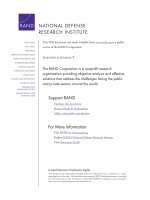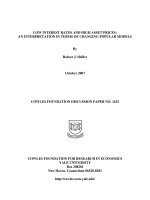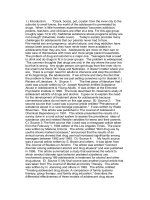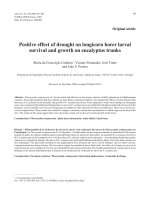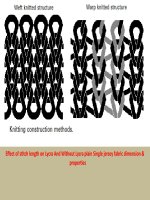Effect of low poly tunnel and planting time on growth parameters and yield of muskmelon
Bạn đang xem bản rút gọn của tài liệu. Xem và tải ngay bản đầy đủ của tài liệu tại đây (116.4 KB, 5 trang )
Int.J.Curr.Microbiol.App.Sci (2019) 8(1): 2735-2739
International Journal of Current Microbiology and Applied Sciences
ISSN: 2319-7706 Volume 8 Number 01 (2019)
Journal homepage:
Original Research Article
/>
Effect of Low Poly Tunnel and Planting time on
Growth Parameters and Yield of Muskmelon
Ashish Ranjan1*, Anand Kumar2, Suraj Prakash1 and Awadhesh Kumar Pal1
1
Department of Horticulture, Bhola Paswan Shastri., Agricultural college, Purnea, India
2
Department of Plant Breeding and Genetics, Bihar Agricultural University, Sabour
(Bhagalpur), India
*Corresponding author
ABSTRACT
Keywords
Musk melon, Poly
tunnel, Planting
time, Growth
parameters and
yield
Article Info
Accepted:
17 December 2018
Available Online:
10 January 2019
To study the impact of low poly tunnel and planting time on the growth parameters and
yield performance of Muskmelon, an experiment were conducted in 2016-17 to 2017-18 at
vegetable experimental farm, Nalanda College of Horticulture, Noorsarai, Bihar
Agricultural University, Sabour (Bhagalpur). The treatments consisted of five date of
sowing i.e.,5th December, 15th December, 25th December, 5th January and 15th January
under open field as well as low plastic poly tunnel respectively. The farmer practice is
taken as a control in open field. Result was found to be significant for growth parameters
and yield. The results clearly indicated that fruit yield/plant (9.07 kg), number of
fruits/plant (18.36), fruit diameter (98.37cm), number of branches (7.05), vine length
(159.24 cm) and number of leaves/plant (144.08) were recorded significantly higher when
the date of sowing was 15th December under poly tunnel as compared to unprotected
condition. Environment is the aggregate of all external conditions which influence growth
and development of plants. Temperature can be controlled and regulated under protected
conditions and better growth of plants might be expected under poly tunnel. Relative
humidity reduces evaporation loss from plants which lead to optimum utilization of
nutrients. It also maintains turgidity of cells which is useful in enzyme activity leading to a
higher yield. However, under farmers field condition 15thFebruary recorded significantly
maximum for fruit yield/plant (10.58 kg), weight of fruit (547.00g), vine length (185.0 cm)
and number of fruit /plant (19.36). As per as net return is concerned, the significantly
higher (Rs 2872040 per hectare) was found under low poly tunnel condition 15th
December sowing overall other treatment. Therefore, it was evident from the above results
that poly tunnel condition found to be the best for higher off season production of
muskmelon and fetch higher return.
Introduction
Profitability
of
vegetable
especially
muskmelon production in Bihar is limited by
a short season. Therefore, most growers’ plant
and harvest at the same time, which drives
prices down (sometimes below breakeven
point) negatively affecting income. The goal
of this study was to investigate poly tunnel
technology as a means to improve
2735
Int.J.Curr.Microbiol.App.Sci (2019) 8(1): 2735-2739
profitability of fresh market vegetables in
Bihar. Poly tunnels allow growers to start
planting earlier, so they can harvest earlier,
and receive a higher price for their produce
before vegetable prices begin to decline in
mid-season. Poly tunnels benefits in musk
melon cultivation including: frost protection,
earliness in planting and harvesting, and
season extension. This study is based on the
impact of poly tunnel and planting time on the
growth parameters and yield performance of
Muskmelon. An analysis was also conducted
to determine the economic benefit of each
system tested. The outcome will be greater
awareness among growers of the potential to
use low tunnel technologies to reduce frost
risks, and enhance earliness and profitability.
The low tunnels had limited effect on total
marketable fruit yields. However, since
market prices were high at the beginning of
the seasons the low tunnel treatments had the
highest net revenue.
Materials and Methods
The present experiment was conducted at
vegetable research farm, College of
Horticulture, Noorsarai, Bihar Agricultural
University, Sabour (Bhagalpur), Bihar during
two years (2016-17 to 2017-18). The
experiment was conducted in randomized
block design in three replications with five
treatments. The treatments consisted of five
date of sowing i.e., 5th December, 15th
December, 25th December, 5th January and
15th January under open field as well as low
plastic poly tunnel respectively. The farmer
practice is taken as a control in open field.
Seedling of muskmelon var. Madhuraja was
planted with spacing of 1.5 m x 30 cm. For
making plastic low tunnel, 60 cm width, 50
cm high and 50 micron transparent plastic
were used, immature bamboo stick were
pegged on the both sides of water channel.
The tunnels were made in north south
direction and vents were made in tunnel on
east side. The five plants were randomly
selected in each treatment for recording
various plant growth parameters and yield
parameters. Mean values of different
characters were used for statistical analysis.
The data were recorded on vine length (cm),
number of branches, vine length, number of
leafs per plant, number of fruits per plant,
fruit diameter, average fruit weight, fruit yield
per plant, average fruit weight and T.S.S.
Mostly artificial soil media was used for
raising healthy and vigorous seedlings of
vegetable in plastic pro- trays. There were
three ingredients viz., cocopeat, vermiculite
and perlite which are being used as a rooting
medium for raising the nursery. Benefit of
this nursery was better root development of
transplants and reduction in the mortality in
transplanting of seedling as compared to the
traditional system of nursery raising.
Seedlings were raised by sowing seeds in
plastic pro-trays which were filled with
growing media prepared by mixing coco. The
treatments consisted of different date of
sowing i.e., 5th December, 15thDecember, 25th
December, 5th January and 15th January in
poly tunnel, Un protected open field and
farmers practice. In treatment T1 to T5 plants
were protected with the help of plastic sheet
but small holes were made with the help of
needle in the plastic sheet. All the cultural
practices were done as per package of
practices for open cultivation. Data was
recorded on number of fruits per plant, fruit
weight (g), yield/plant (g), average fruit
weight (g) and total fruit yield (q/ha).
Results and Discussion
The analysis of pooled data for two years
(Table-1) revealed that revealed that number
of fruits per plant, fruit weight, yield per plant
and yield per hectare, were significantly
influenced by the growing environment
conditions and planting time. Maximum
number of fruits per plant, yield per plant and
2736
Int.J.Curr.Microbiol.App.Sci (2019) 8(1): 2735-2739
yield per hectare were found when the
planting was done on S2 = 15th December
under low tunnel followed by S5= 15th
January over other date of sowing under low
tunnel. Fruit weight was recorded in S5= 15th
January followed by S4= 5th January under
low tunnel whereas under open field
condition, it was noticed maximum in
condition on 15th December date of planting.
Low tunnels modify microclimate by raising
soil and air temperatures. In general, low
tunnels allow shortwave solar radiation to
pass through during the day and the plastic
material slows long wave radiation from the
surface at night (Snyder and Melo-Abreu,
2005). The heat that is absorbed could not
easily be passed down into the soil because of
the insulation of the air between the low
tunnel, plastic mulch, and the soils surface.
The interior microclimate is further modified
as the tunnel material slows convective
mixing over the covered surface, reducing
both sensible and latent energy losses from
the surface (any condensation that does occur
on the plastic will release latent heat and
warm the plastic) and increasing the ground
heat flux.
Table.1 Effect of planting time and growing conditions on growth and yield attributing
parameters of Muskmelon
Treatments
Low Poly tunnel S1 = 5th
December
Low Poly tunnel S2 = 15th
December
S3= 25th December
Low Poly tunnel S4= 5th
January
Low Poly tunnel S5= 15th
January
Open field condition S1 =
5th December
Open field condition S2 =
15th December
Open field condition S3=
25th December
Open field condition S4=
5th January
Open field condition S5=
15th January
Farmers practice S6=
15th February
SEm(+-)
CD at 5%
No. of
fruits per
plant
13.26
Average Fruit
wt (g)
Fruit yield per
plant (Kg)
Yield (q /ha)
482.70
06.40
1066.62
18.36
494.06
09.07
1511.60
13.20
15.26
504.40
505.37
06.65
07.71
1108.28
1284.94
16.00
523.66
08.37
1394.94
06.00
226.33
01.35
0224.99
09.33
448.00
04.17
0694.97
05.13
375.06
01.92
0319.98
09.43
256.20
02.41
0401.65
11.00
260.50
02.86
0476.64
19.36
547.00
10.58
1763.26
1.38
4.4
39.02
123.0
0.73
2.3
48.0
223
2737
Int.J.Curr.Microbiol.App.Sci (2019) 8(1): 2735-2739
Table.2 (Contd.) Effect of planting time and growing conditions on growth and yield attributing
parameters of Muskmelon
Treatments
Low Poly tunnel S1 = 5th
December
Low Poly tunnel S2 = 15th
December
S3= 25th December
Low Poly tunnel S4= 5th January
Low Poly tunnel S5= 15th January
Open field condition S1 = 5th
December
Open field condition S2 = 15th
December
Open field condition S3= 25th
December
Open field condition S4= 5th
January
Open field condition S5= 15th
January
Farmers practice S6=
15th February
S.E. (+-)
CD at 5%
No. of Leafs per
plant
88.00
Vine length (cm)
T.S.S
98.00
Fruit diameter
(mm)
88.67
144.08
159.24
98.37
9.87
119.33
152.00
148.33
84.00
119.33
152.33
148.33
111.66
97.78
99.96
98.13
80.26
10.19
10.62
10.93
9.92
119.33
122.33
84.91
10.17
109.33
109.33
93.26
10.43
121.00
120.33
78.94
9.15
148.33
185.00
95.52
10.10
151.66
185.00
105.71
10.89
8.18
25.8
9.70
30.6
3.55
11.2
0.17
0.6
The present investigation also revealed that total
fruit yield was significantly higher in low tunnel
than open field condition and almost double
than the open field crop. Buczkowska et al.,
(1994) revealed that total yield under low tunnel
was higher than under open conditions. Sari et
al., (1994) reported that increase in yield under
low tunnel was due to increase in harvesting
span in cucumber. Fruit number per plant was
recorded more under protected conditions and it
was significantly higher than open field crop.
This is due to the fact that muskmelon grown
under plastic tunnel got favourable conditions
for maximum growth, flowering and fruiting in
comparison to other treatments resulting in
more number of fruits per plant. Kacjan and
Osvald (1997) obtained more fruits per plant
under plastic tunnel in pepper. They attributed it
to the increase in temperature in tunnel during
the cold which results in more growth and yield
of the crop. The average fruit weight under low
8.20
tunnel was also significantly higher than other
treatments. It was also observed that average
fruit weight in first two picking was
significantly higher in low tunnel than the
unprotected. Macua et al., (1999) reported in
tomato that by use of plastic covers the crop get
early and prolong for longer duration than the
normal grown crop. The results obtained during
the two year study clearly indicated that the
technology will help the growers to raise the
muskmelon in early summer and increase the
harvesting span of the crop fetching higher
price. The other yield contributing traits like
number of leafs per plant was noticed maximum
in S4 = 15th January followed by S5= 15th
January under low tunnel condition followed by
S5= 15 January under open system. Vine length
was recorded maximum in S2= 15th December
under low tunnel condition followed by S5=
15th January in open system. Fruit diameter and
T.S.S. recorded maximum in S4= 5th January in
2738
Int.J.Curr.Microbiol.App.Sci (2019) 8(1): 2735-2739
low tunnel followed by S6= 15th February in
framer practice.
Maximum yield in muskmelon was recorded in
S2, it might be due to better growth and
development of all yield contributing
parameters of muskmelon under low tunnel
which were due to increases the net
photosynthesis and production of more
assimilates available for individual to grow.
Similar results were also given by Singh el al
(1989). Vegetative growth was greatest in
plants in the tunnel where the thermal condition
were best early and total marketable yield were
highest under the poly tunnel (Siwek and
Capecka 1999). It is important to note that no
significant differences were observed in fruit
weight in both condition i.e., grown in tunnels
and in open field. Net income and cost benefit
ratio is significantly influenced by off season
flowering and fruiting induced by low tunnel
technology. Net income and cost benefit ratio
was found maximum when sowing the crop on
15th December under low poly tunnel. This
might be due to high market value in offseason. Growers typically reported satisfaction
with adopting this technology. Poly tunnels
allow muskmelon growers to start planting
earlier, so they can harvest earlier, and receive a
higher price for their produce before vegetable
prices begin to decline in mid-season.
References
Buczkowska, H., Babik, I. and Rumpel, J.
(1994). Usefulness of a slidable tunnel
in accelerated vegetable growing.
Seventh International symposium on
timing field production of vegetables.
Acta Hort., 371: 297-304.
Cheema, D.S., Kaur, P. and Kaur, S. (2004).
Offseason cultivation under net house
conditions. Acta Hort., 659: 177-81.
Kacjan Marsin, N. and Osvald, J. (1997). The
influence of different cover materials of
greenhouses
on
growth
and
development of pepper (Capsicum
annuum L.). Zbornic BiotehniskeFakultete-Univerze-v-Ljubljani,Kmetijstvo, 69: 141-46.
Immirzi, B; Malinconico, M; Casale, E.,
Mormile, P., Shenker, Y. and BenYehoshua, S. (1998). Testing of
innovative co-extruded films in
anticipated cultures in South Italy. 14th
International Congress on Plastics in
Agriculture. Tel Aviv, Israel, March
1997-1998, pp. 177-80.
Macua, H; Santos, A. and Zuniga, J. (1999).
The effect of the planting date on the
programmation of yield and quality of
processing tomato in Navarre (Spain).
Acta Hort., 487: 229-32.Pakyurek,
A.Y., Abak, K., Sari, N., Guler, H. Y.,
Cockshull, K.E., Tuzel, Y. and Gul, A.
(1994). Influence of mulching on
earliness and yield of some vegetables
grown under high tunnels. Second
symposium on protected cultivation of
solanacea in mild winter climates,
Adana, Turkey, 13-16 April 1993. Acta
Hort., 366: 155-160.
Sari, N., Guler, H.Y., Abak, K., Pakyurek, Y.,
Babik, I. and Rumpel, J. (1994). Effect
of mulch and tunnel on the yield and
harvesting period of cucumber and
squash.
Seventh
International
symposium on timing field production
of vegetables, Skierniewice, Poland, 2327 August 1993. Acta Hort., 371: 305310.
How to cite this article:
AshishRanjan, Anand Kumar, Suraj Prakash and Awadhesh Kumar Pal. 2019. Effect of Low Poly
Tunnel and Planting time on Growth Parameters and Yield of Muskmelon.
Int.J.Curr.Microbiol.App.Sci. 8(01): 2735-2739. doi: />
2739

